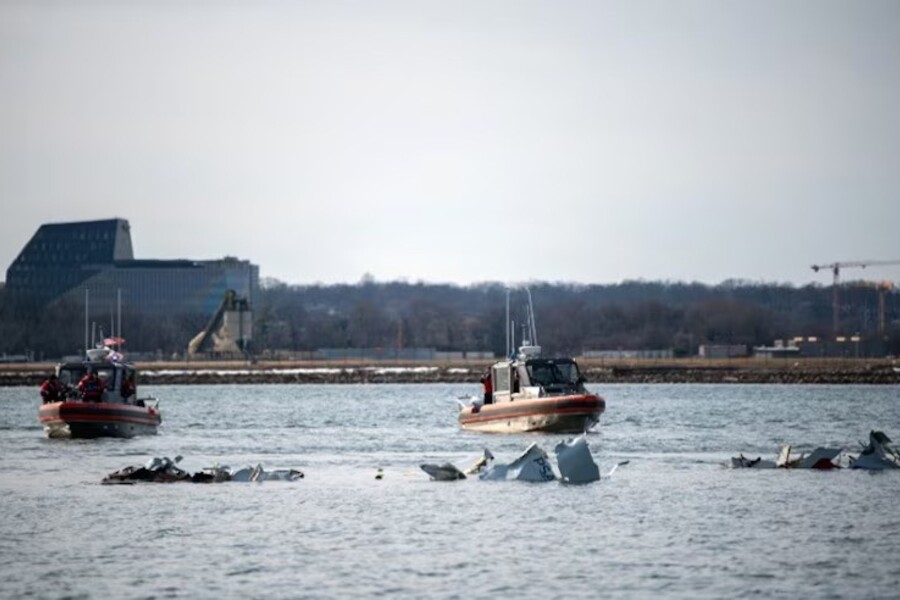A devastating midair collision between an American Airlines regional jet and a U.S. Army Black Hawk helicopter over the Potomac River near Washington, D.C., claimed the lives of all 67 people aboard both aircraft on Wednesday night. The incident sparked a major investigation led by the National Transportation Safety Board (NTSB) with assistance from the Federal Aviation Administration (FAA) and the U.S. military.
American Airlines Flight 5342, a Bombardier CRJ700, was on final approach to Ronald Reagan Washington National Airport after departing from Wichita, Kansas. The plane carried 64 passengers and crew members. Meanwhile, the Black Hawk helicopter, on a routine training mission with three crew members, collided with the passenger jet, causing both aircraft to crash into the river in flames.
Speaking at a press conference, Transportation Secretary Sean Duffy confirmed that both aircraft had been following standard flight paths before the collision. He described the incident as “absolutely preventable” despite normal flight conditions and clear skies. “It is not standard to have aircraft collide,” Duffy said, emphasizing that the investigation would focus on communication and procedural errors leading up to the crash.
Former President Donald Trump took to his Truth Social platform to express his concerns and question air traffic control’s role in the tragedy. “It is a CLEAR NIGHT, the lights on the plane were blazing. Why didn’t the helicopter go up or down, or turn? Why didn’t the control tower tell the helicopter what to do instead of asking if they saw the plane?” Trump wrote.
During a White House press briefing, Trump also criticized the FAA’s diversity, equity, and inclusion (DEI) hiring policies, suggesting without evidence that they may have contributed to the crash. When questioned by ABC News reporter Mary Bruce, Trump admitted, “We don’t know” the cause but insisted his conclusions were based on “common sense.”
Defense Secretary Pete Hegseth expressed condolences to the victims’ families and pledged full cooperation with the investigation. “The military does dangerous things, it does routine things regularly. Tragically, last night a mistake was made,” Hegseth said.
The NTSB has retrieved the black boxes from both aircraft. These include the cockpit voice recorder and flight data recorder from the submerged American Airlines jet and a combined cockpit voice and data recorder from the Black Hawk helicopter. Todd Inman, a member of the NTSB board, expressed confidence that the data would help clarify what happened. “Our mission is to understand not just what happened, but why it happened and to recommend changes to prevent it from happening again,” Inman said.
At a press conference, NTSB Chair Jennifer Homendy assured the public that the investigation would be thorough and leave “no stone unturned.” Fifty investigators have been deployed to examine the mechanics of both aircraft, air traffic control communications, and potential human error. The NTSB expects to release a preliminary report within 30 days.
A key part of the investigation will focus on recorded communications between Ronald Reagan Washington National Airport’s air traffic control (ATC) and the helicopter crew. In a recording released by LiveATC.net, the controller is heard asking the helicopter crew, identified as “PAT 25,” if they had the American Airlines jet in sight. After confirming visual contact, the controller directed the helicopter to “pass behind the CRJ” and maintain visual separation. Despite this, the collision occurred moments later. Investigators are now probing why the helicopter remained on a collision course.
Duffy confirmed that the helicopter crew was aware of the passenger jet but noted that procedural questions remain. A source familiar with airport operations revealed that the control tower had combined two positions into one about 40 minutes before the crash due to reduced air traffic. While routine, this operational change is now under scrutiny.
Security footage captured the final moments of the collision, showing the American Airlines jet on its approach to the runway when it was struck by the helicopter. Both aircraft exploded and plunged into the Potomac River, marking the first major U.S. air disaster in nearly 16 years.
American Airlines has announced that it will retire flight number 5342, a standard practice following major aviation incidents. CEO Robert Isom expressed sorrow over the tragedy, stating that the captain of the flight had been with the airline for six years, while the first officer had served for two years. Runway 33 at Reagan National, where Flight 5342 was scheduled to land, will remain closed until February 7.
The collision has sent shockwaves throughout the aviation and military communities. Residents near the crash site have organized memorials and vigils to honor the victims. “This is a heartbreaking day for everyone in aviation,” NTSB Chair Homendy said. “Our hearts go out to the families and loved ones of those lost.”
President Trump, who was briefed on the investigation by NTSB officials, said he would continue to monitor the situation. Both American Airlines and the U.S. military have pledged full cooperation.
“We’re committed to learning from this tragedy and ensuring that it never happens again,” said Inman. As the investigation progresses, the aviation industry is bracing for potential regulatory changes aimed at improving air traffic coordination, especially in high-density airspace like Washington, D.C.
The nation mourns the lives lost in this devastating accident, with many hoping that the findings of the investigation will prevent future tragedies in the skies.

